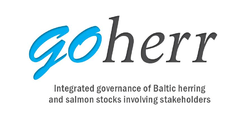GOHERR:Internal meeting of WP 2 and 3 Oulu 020615
An internal meeting between WP2 and WP3 was held on 2nd of June in Thule institute, University of Oulu. The meeting started at 9.30 and ended at 15.30. Participants: Suvi Ignatius (UH), Päivi Haapasaari (UH), Mia Pihlajamäki (UOul), Timo Karjalainen (UOul), Simo Sarkki (UOul). The aim of the meeting was to elaborate aims and plans of WP2 and WP3, and links between the WPs.
The importance of collaboration, interaction and openness between the WPs was discussed, to ensure the compatibility of outputs of WP2 and WP3, and the relevancy of the outputs for WP6. The suitability of the value theory of Boltanski and Thévenot to both WP2 and WP3 was discussed.
WP2.1. Literature reviews on the socio-cultural importance and use of Baltic salmon and herring
- Suvi presented the theory of Boltanski and Thévenot (![]() sosiokulttuuriset_arvot02062015_Oulu). The suitability of the theory for the needs of the project was discussed. All agreed that the theory seems to be useful and that it can bring new interesting aspects to the analysis of the values of Baltic salmon and herring and their governance - and overall to fisheries management research.
sosiokulttuuriset_arvot02062015_Oulu). The suitability of the theory for the needs of the project was discussed. All agreed that the theory seems to be useful and that it can bring new interesting aspects to the analysis of the values of Baltic salmon and herring and their governance - and overall to fisheries management research.
WP2.2.b A literature review of the legal and policy frameworks related to management of the Baltic salmon and herring. Different policy frameworks to be included in the literature review were mapped, and it was noticed that they overlap with the documents that will be investigated in the objective setting in WP3.1. The following policy frameworks were listed: EU Common Fisheries Policy, EU Strategy for the Baltic Sea Region, Baltic Sea Action Plan, EU Documents related to the planning of the long term management plan for Baltic salmon stocks (http://ec.europa.eu/dgs/maritimeaffairs_fisheries/consultations/baltic_salmon/index_en.htm), the multi-annual plan by the European Commission regarding Baltic herring (http://eur-lex.europa.eu/legal-content/EN/TXT/PDF/?uri=CELEX:52014PC0614&from=EN), Finnish strategy for salmon fishery for 2014-2020 and other national policy frameworks.
WP3.1. Defining desired future state and objectives for integrated salmon and herring policy A questionnaire will be targeted to key stakeholders, fall 2015. The main aim of the questionnaire is to find out the respondents' preferences related to the objectives of salmon and herring management. The questionnaire will be prepared based on 1) A review on relevant policy documents in WP3, and 2) The work related to values conducted in WP2. The questionnaire will also serve WP2, if possible, and for this WP2 will provide a list of relevant value-related questions. The questionnaire will be conducted by Webropol and it will be sent to a wide sample (stratified purposeful sampling) of people representing different stakeholder groups.
Blogs by PhD students to BONUS Projects web page The BONUS secretariat has requested PhD students/young scientists to keep blogs on their experiences within the project. It was agreed that Suvi and Mia will make a plan for the blogs (frequency, themes). The plan is that Suvi, Mia and potentially also the PhD student of SLU will keep blogs, one at a time. All blog texts will be first sent to Päivi who will then accept them and forward to BONUS.


